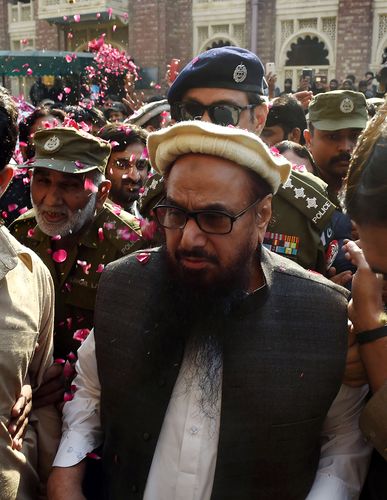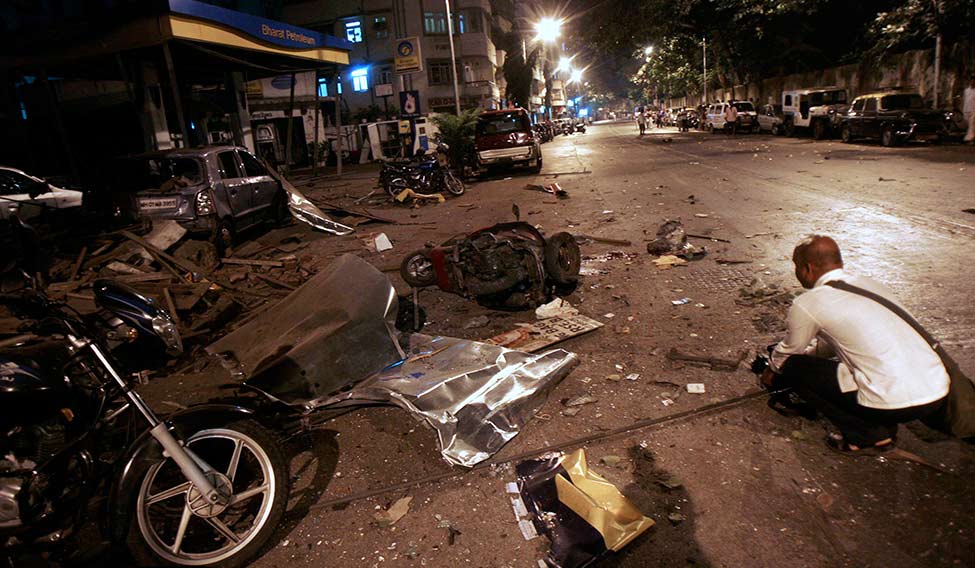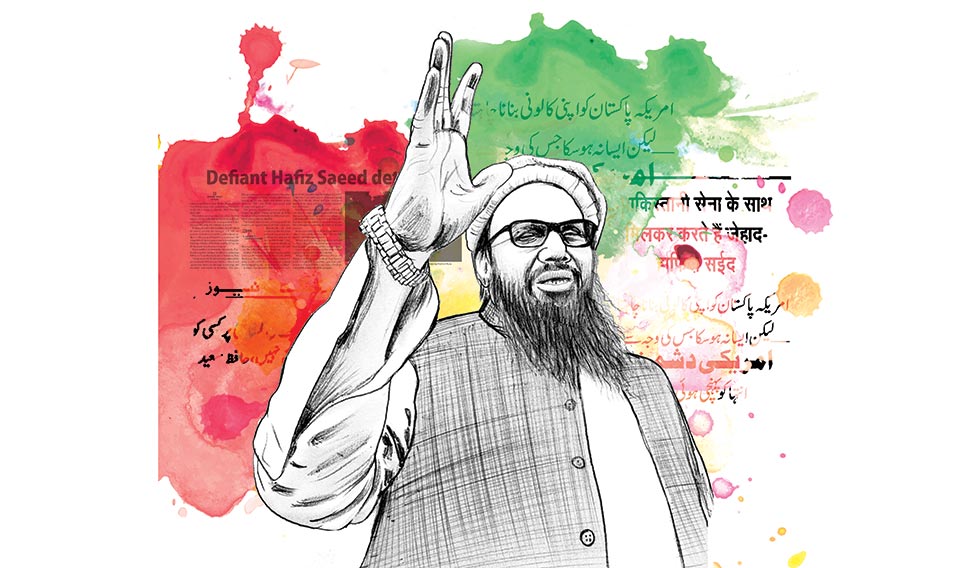The burly, bearded man’s biggest weapon is his tongue. Every Friday, he spits venom against India, exhorting fellow Muslims to liberate the land from Hindus. He hates the country, where his forefathers once lived, so much that he wanted his mujahideen to break it and create three Pakistans.
Sitting in Lahore, Hafiz Muhammad Saeed has been bleeding India for two decades. Lashkar-e-Taiba, a terrorist organisation he founded, has carried out hundreds of terrorist attacks in India, including the 2008 attacks in Mumbai and the attack on Parliament in 2001. While Saeed, 69, says he no longer has any connection to LeT, Indian security forces have no doubt he is still its true leader.
Many people call Saeed the ‘ideological hater’, and without doubt his religious views are the main reason for his hatred of India. Another one could be an incident which happened a year before he was born—while migrating from Hisar in Haryana to Lahore during the partition, his family lost 36 members to rioting mobs.
Kashmir was Saeed’s gateway to India. In 1996, when he was just getting a foothold in the valley, he said Kashmir’s liberation would be followed by liberation of Muslims in north and south India. “From the door of Kashmir we will launch Gazwah-e-Hind (battle for Hindustan),” he said. Lashkar’s first major strike was in 1998 in Wandhama, in which terrorists killed 23 Kashmiri Pandits. The same year, it attacked a wedding party in Doda and killed 25 people.
Founded in 1987 with the aim of fighting the Soviet-backed Najibullah regime in Afghanistan, Lashkar turned its attention to Kashmir after the Taliban captured power in Kabul in 1996. In a few years, with the generous support of the Pakistani spy agency Inter-Services Intelligence, it eclipsed terror groups like Hizb-ul-Mujahideen and Jaish-e-Muhammad that had been active in the valley. “Hafiz Saeed is the baby of the ISI,” said Arun Choudhary, former special director in the Intelligence Bureau. “From 1997 onwards, when the LeT came to Kashmir, they recruited the youth from rural Pakistan, which includes Punjab and the villages on our international borders. They were fed the hate ideology by Saeed in madrassas and rallies. At every platform of the so-called charity organisation Jammat-ud-Dawah (JuD) and the LeT, the anti-India propaganda is being carried out.”
 Proxy war: Saeed is protected not just by his own men but also by the Pakistani state | AFP
Proxy war: Saeed is protected not just by his own men but also by the Pakistani state | AFP
Saeed formed the JuD in 2002 as a front for the LeT after it was designated as a terrorist organisation by the US a year earlier. India had run a campaign against the LeT after it launched an audacious attack on Parliament in December 13, 2001. But what propelled the outfit to notoriety was the assault on Mumbai in 2008, when ten of its terrorists, all Pakistanis, carried out 12 shooting and bombing attacks across the city, killing 166 people. India put in a formal request to the UN Security Council to put the JuD and Saeed on the list of individuals and organisations sanctioned by the UN.
Despite a US bounty of $10 million on his head and being wanted in India in many cases, Saeed has mostly been a free man in Pakistan. In fact, his public life has been an act of mocking defiance against those who wanted him. It was in 2001 that Pakistan detained Saeed for the first time, after India’s accusations of his involvement in the attack on Parliament. In a few months, however, the police let him go. He was arrested again after the 2006 Mumbai train bombings, but was released soon. Then in 2008, he was held in house arrest, but was released within a year. He was put under house arrest in January this year, and released on November 24. “We swear to continue our jihad,” he said, addressing his supporters who gathered in Lahore to greet him after his release. “We don’t care what the world is saying. Let the US say whatever it wants. Let India keep shouting. We don’t care, we will continue our jihad till the end.”
India has been trying to extradite Saeed for a decade. In 2011, it publicised a list of its 50 most wanted fugitives hiding in Pakistan, which included Saeed. But these efforts always hit a wall in Pakistan. After releasing Saeed on November 24, Pakistan Prime Minister Shahid Khaqan Abbasi said if India had evidence against him, it should pursue the charges on an international forum.
Ramesh Mahale, chief investigating officer of the 26/11 terror attacks, said there were three pieces of evidence that established Saeed’s role in the crime. “The first one is 26/11 terrorist Ajmal Kasab’s confessional statement where he disclosed how Saeed visited the Lashkar training centres and motivated the ten terrorists to execute the Mumbai attacks,” he said. The second is American David Coleman Headley’s statements to the National Investigation Agency. Headley, who was sentenced to prison by a US court for his involvement in the Mumbai terror attacks, deposed before a Mumbai court via video link from the US earlier this year and identified Saeed. The third piece of evidence came from terrorist Abu Jundal, who was in the control room in Karachi when the terror strikes happened. Jundal told the interrogators that Saeed was present in the control room.
“The evidence we gathered pointed towards the well-orchestrated plot hatched by Pakistan with the help of Hafiz Saeed,” said M.L. Kumawat, who was a special secretary (internal security) in the home ministry when the Mumbai terror attacks happened. “This is the primary reason he is still roaming around freely in that country. He should be handed over to India or killed in a drone strike or like Osama bin Laden was eliminated by the US. Why should we apply different yardsticks in the two cases. Saeed was the commander of the 26/11 strikes.”
Saeed and Laden (who waged a war against the US and was killed by an American special operations unit in Pakistan in 2011) have a lot in common. Both these ardent soldiers of militant Islam have been driven by hate—Laden his hatred of the US, and Saeed his hatred of India. Like Laden did, Saeed uses his venomous tongue to run a machinery that churns out terrorists.
Saeed finds his men from the vast ‘talent pool’ in Punjab and the villages that border India. Intelligence officials say whenever he visits Muzaffarabad in Pakistan-occupied-Kashmir, he scans for fresh recruits. Freedom of Kashmir from the Hindu India is his main vehicle for indoctrinating them. He demonises India in every possible way. “He tells them India tries to cut water flowing into their country,” said Choudhary.
 Bloody battle: The 2008 terror attacks in Mumbai by Lashkar-e-Taiba killed 166 people | Reuters
Bloody battle: The 2008 terror attacks in Mumbai by Lashkar-e-Taiba killed 166 people | Reuters
In 2014, Saeed blamed India for the floods in Jammu and Kashmir, saying New Delhi had launched a “water war” on Pakistan. “Occupied Kashmir cannot be looked after by the Modi government; what can it do for those in Azad Kashmir? Give them freedom if you may,” he ranted. Then he tweeted: “India has used water to attack Pakistan. We are in a state of war. India’s water aggression must be taken to the UN Security Council.”
Saeed runs some 260 schools in Pakistan, and numerous training camps for terrorists. These camps supply footsoldiers for the ISI’s shadow war against India. According to American academic Stephen Tankel, who has written a book on the LeT, there is a strategic culture in Pakistan of using proxies. The country is so used to using proxies that it is finding it difficult to let it go.
That is why Saeed is protected not just by his own men but also by the Pakistani state. Even when he is not under house arrest, his Lahore house—a fortified structure with a mosque, an office and an army of men wielding Kalashnikovs—has round-the-clock police protection. There is usually a police picket near his house and regular patrolling around the area.
After the international backlash following the 2008 Mumbai terror strikes, Saeed’s attacks against India have mostly been verbal. Many analysts say it was a calculated move as he harbours political ambitions. Saeed himself had admitted that the political movement would be at the forefront of his mission. His intentions became clear when he recently announced that the Milli Muslim League, a political party he launched a while ago, would contest the next year’s general elections.
While some analysts see it as a positive move, some say it would not change anything or might be more dangerous, as Saeed would remain a proxy of the Pakistan Army and the ISI. The army had proposed a plan to bring Saeed to the mainstream when Nawaz Sharif was the prime minister, but he rejected it. Though, historically, religious parties have never won more than a few seats in Pakistan parliament, none of them had leaders as charismatic and influential as Saeed.
His foray into politics is unlikely to take Saeed’s focus away from India. In fact, in the same speech he announced the decision to contest the elections next year, he dedicated 2018 to Kashmiris and their freedom. “I want to tell India that I will continue to support Kashmiris no matter what kind of difficulties are there,” he said. Indian intelligence agencies say some 600 terrorists are waiting at his terror camps to infiltrate into Indian territory this winter. It seems India’s No 1 enemy is just getting ready for another battle.
WITH TARIQ BHAT







